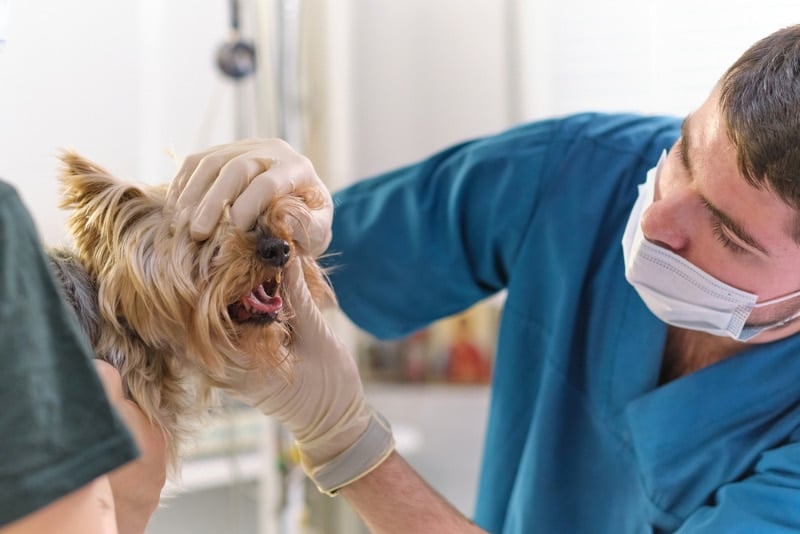In this article
View 5 More +The larynx is composed of arytenoid cartilage, which helps close off the trachea when a dog eats or drinks, protecting the lungs from the inhalation of foreign material. The cartilage can then open up the airway when more air is needed.
The larynx is also known as the voice box, as it’s where the vocal cords are located. The surrounding muscles help support its structure. When the nerves supplying these muscles become weak or paralyzed, they can no longer support the larynx properly, and the cartilage collapses inward, causing laryngeal paralysis.

What Is Laryngeal Paralysis?
Laryngeal paralysis occurs when there is a loss of nerve function controlling the larynx. When it’s not functioning properly, it causes the airway to narrow, making breathing difficult. Imagine trying to breathe through a straw and how uncomfortable that would feel. The signs may be mild but can progress, potentially leading to a medical emergency.


What Are the Signs of Laryngeal Paralysis?
- Coughing
- Gagging
- Regurgitating
- Vomiting
- Noisy breathing
- Exercise intolerance
- Excessive panting
- Bark sounds hoarse (dysphonia)
- Respiratory distress
- Bluish color to the mucous membranes
- Collapse
Laryngeal paralysis more commonly affects middle-aged and older dogs, particularly in medium and large breeds. Signs can vary but usually include coughing after exercise (which can also be stimulated by eating or drinking), noisy breathing, intolerance to exercise, panting excessively, and dysphonia, which is a change in the sound of your dog’s bark. The signs may worsen over time and can become a medical emergency.
If your pet is showing these signs, we suggest you speak to a vet.
If you need to speak with a vet but can't get to one, head over to PangoVet. It's our online service where you can talk to a vet online and get the advice you need for your dog — all at an affordable price!

What Causes Laryngeal Paralysis?
- Trauma to the neck or throat
- Tumors in the neck
- Hypothyroidism
- Cushing’s disease
- Congenital form (present at birth)
- Acquired form (neuromuscular disease, such as geriatric onset laryngeal paralysis or polyneuropathy)
Certain breeds are more commonly affected, but this condition can occur in all dogs. Labrador Retrievers typically get the acquired form of the disease, while Bouvier des Flandres, Siberian Huskies, American Staffordshire Terriers, Black Russian Terriers, Rottweilers, and Dalmatians often have the congenital form. This may develop much earlier than the acquired form, as early as 3 months of age.

How Do I Care for a Dog With Laryngeal Paralysis?
Laryngeal paralysis is diagnosed based on your dog’s clinical signs and complete medical history. Your veterinarian will perform a thorough physical and neurological exam and may recommend blood and urine tests. Neck and chest X-rays are often indicated. An evaluation of your dog’s larynx with a laryngoscope or endoscope is necessary to confirm laryngeal paralysis. This is completed with your dog under sedation.
Avoid collars, leashes, or anything that puts pressure on your dog’s neck. Harnesses are ideal for dogs with this condition. Limit strenuous exercise or exposure to hot environments that could exasperate your dog’s signs. Preventing excitement and stress and working on weight loss if your dog is obese can also improve clinical signs.

How Is Laryngeal Paralysis Treated?
In mild cases, laryngeal paralysis can be controlled with medications prescribed by your veterinarian.
- Anti-inflammatories
- Antibiotics
- Sedatives
Other dogs with more severe signs can benefit from surgery to correct the condition, improving their quality of life. One common procedure is the tie-back surgery, which ties the collapsed cartilage to the larynx, opening it up and preventing it from blocking the airway. Your veterinarian will be able to determine the best course of action and discuss any anesthetic risks that your dog may encounter during the surgical procedure. Unfortunately, dogs with laryngeal paralysis can have an increased risk of anesthetic complications.

Frequently Asked Questions
What Other Medical Conditions Can Mimic the Signs of Laryngeal Paralysis?
Other conditions with similar signs include heart disease, respiratory disease, advanced age, and obesity.
What Are the Signs of Aspiration Pneumonia?
Signs of aspiration pneumonia may include anorexia, fever, lethargy, persistent cough, and nasal discharge.

How Will My Veterinarian Treat a Respiratory Emergency?
Your veterinarian may provide supplemental oxygen, administer IV fluids, give sedation, and reduce stressors to prevent the exacerbation of respiratory distress. If the respiratory distress is severe enough, a tracheotomy may be needed.

Final Thoughts
Laryngeal paralysis is a condition in dogs where the larynx, or voice box, loses the nerve function to control the opening and closing of the cartilage. The signs may include raspy breathing, hoarseness, coughing, and gagging. The causes may include trauma to the larynx or neck area, tumors, endocrine disease, genetics, or an age-related acquired form. Treatment can be conservative in mild cases or may require surgery to improve your dog’s quality of life in severe cases. This condition requires lifelong monitoring and management to ensure your dog’s comfort and safety.
See also:
- Do Dogs Have Adam’s Apples? Canine Anatomy Explained (Vet-Verified)
- Do Dogs Have Vocal Cords? Canine Vocalization Explained (Vet-Reviewed)
Featured Image Credit: Kurit afshen, Shutterstock


















